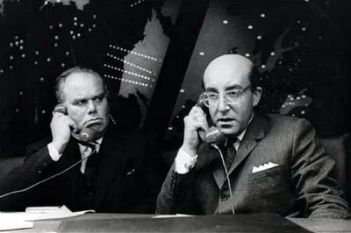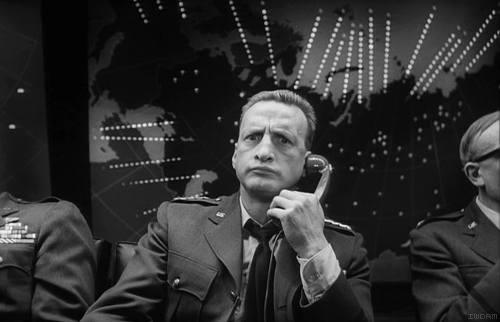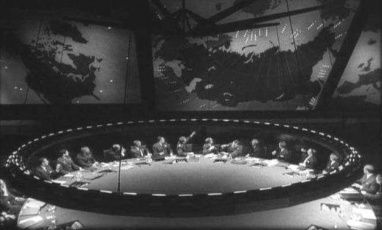
Dr. Strangelove or: How I Learned to Stop Worrying and Love the Bomb
1964
Director: Stanley Kubrick
Starring: Peter Sellers, Peter Sellers, Peter Sellers, George C. Scott, Sterling Hayden, Slim Pickens
In 1964, Hollywood produced two films about the threat of nuclear war. The country was in high paranoia, and there was constant fear about nuclear attack. One of these two films was a harrowing drama. The other was a satirical black comedy. Few people remember the drama (Fail Safe, starring Henry Fonda), but the satire, Dr. Strangelove, is still revered to this day.
An off-his-rocker general, General Jack Ripper (Hayden), issues the go codes for B-52 bombers to drop nuclear bombs on Russia and manages to convince his air force base that the US is under attack from the Russians. The US President, Merkin Muffley (Sellers), summons his heads of state to alert the Russians and call back the bombers, which works… except for one plane that doesn’t get the message. Sounds serious!
Practically the textbook definition of “Black Comedy,” this is a wickedly funny and shockingly scary film. Kubrick had the presence of mind to understand that the comedy was needed to help Americans swallow the bitter pill about the possibility of nuclear war. The laughs come at some of the most unexpected places, intercut with the seriousness of a nuclear war. A fantastically funny early sequence has George C. Scott’s character, General Turgidson, with his “secretary,” tanning herself in a bikini in their “office.” A commander calls him to tell him about the deployment of the bombs, but the secretary answers, and starts making purring noises at the commander on the other end of the phone as well. It’s so unexpected when she says, “This is his secretary,” and then later, “Oh hi, Freddy, how are you, baby?” Probably the last thing you’d expect to see in a movie about nuclear war.

Peter Sellers, Peter Sellers, and Peter Sellers are all amazingly funny, and carry most of the comedy of the film. For my money, I don’t think there’s a funnier scene than when Peter Sellers as President Muffley calls the Russian Premier, Dimitri, and tells him with a laugh in his voice that “One of our generals went and did a silly thing.” Just how vastly that understates the seriousness is so ludicrous, it becomes comical. The fact that this is followed by conversations about “All right, you’re sorrier than I am, but I’m sorry as well!” is just the completely outrageous icing on the comedic cake. His turn as Captain Mandrake, a British RAF officer on loan, as it is, to the US Air Force, who tries to talk down the crazy General Ripper, is equally funny. Toothy grins and a thoroughly upper crust accent, he is full of, “If those devils come back, we’ll just give them the machine gun again, old boy.” He is so stuffy, and is so utterly out of his element in trying to deal with the utterly insane Ripper. It’s almost as if Colonel Blimp was in the part rather than Peter Sellers. His final turn as the completely nutty Dr. Strangelove, the wheelchair bound and Hitler loving Doomsday Device enthusiast, is so wildly crazy and ridiculous that he is automatic comic relief, although I personally prefer the other two roles. Apparently, Kubrick also wanted Sellers to play the part of the bomber pilot captain that ultimately went to Slim Pickens, but Sellers thought it was too much and refused. Good thing, too; I cannot picture Sellers playing the role quite as seriously as Slim Pickens did (Kubrick didn’t tell him the film was a comedy), and the film needs a little bit of seriousness here and there to get its ultimate message across.
Amazingly enough, the one actor in the film who manages to top Peter Sellers crazy comic antics is George C. Scott, an actor typically known for his dramatic turns. His role as General Turgidson is so ridiculous, so over the top, so rubber faced in his buffoonery, it feels as though he’s channeling Jim Carrey. His Turgidson is so adamantly pro-war that he actually says wistfully of Strangelove’s Doomsday Device, “Gee, I wish we could get our hands on one of those!” When presenting the case FOR nuclear war to the President, he says, “Mr. President, I’m not saying we wouldn’t get our hair mussed. But I do say no more than 10 to 20 million killed, tops. Depending on the breaks.” Oh, is that all? In squeezing this brilliantly comic performance from Scott, himself an incredibly opinionated curmudgeon who took everything serously, Kubrick apparently asked him for one completely crazy take for all his shots, then ended up using the most over the top takes to stitch this crazy performance together. Scott was apparently shocked and angered when he finally saw the edit, as it’s not as HE imagined it, but it’s undoubtedly one of his finest films.

At the heart of the entire bomb mess is General Jack Ripper, played by Sterling Hayden. His insanity and his constant ramblings about “bodily fluids” and “life essence” are so preposterous, so out there, that they become enormously funny. Hayden, an actor I grow more impressed with the more I see him, is perpetually Ripper in my mind, despite the fact that I’ve seen him in several other films.
The photography is just stunningly gorgeous. Crisp, clean, shockingly clear black and white shots show everything in immense detail. Working essentially only in three sets – the war room, General Ripper’s office, and the cockpit of the rogue bomber – Kubrick opts for long shots, preferring for extended two-shots rather than intercutting back and forth between close-ups. His wide shots of the war room are particularly striking, with the enormous, all-encompassing maps of Russia and the US and nuclear targets behind the circular table. The huge, circular lamp that hangs low over the table throws everyone into sharp relief. Even though this is a black and white film, we clearly see Kubrick’s penchant for bright fluorescent lighting in this shot, and in earlier scenes in Ripper’s office. I love Kubrick’s use of fluorescent lighting, and it’s exhilarating to see it in this earlier film of his.

Filled with iconic movie images and lines – Slim Pickens riding the nuclear bomb down to its target, the cry of “Gentlemen, you can’t fight in here, this is the War Room!” – Dr. Strangelove remains an important satire. The weightiness behind the topic is made easier to swallow by the deft comedy in the rest of the film, but Kubrick never makes the threat of nuclear war seem insignificant. Despite all its laughs, I still think this is a scary film. How badly do I want the rogue bomber to get word to stop their attack… but they never do. Nuclear war is NOT averted, and it IS a horrible thing, it’s just that Kubrick can make us laugh while feeling uncomfortable. It’s truly a brilliant film.
Arbitrary Rating: 10/10
"Peter Sellers, Peter Sellers, and Peter Sellers are all amazingly funny"
ReplyDelete..so true! That said, you forgot Peter Sellers. He was the standout for me.
As a Brit, Captain Mandrake was one of my favourite characters but there are so many good moments to be seen here.
Ed - Empire's 5-star 500
Love Mandrake. Oddly enough, I find Dr. Strangelove to be the least interesting of Sellers' performances!
DeleteI totally agree on every word in your review. I think i have finally decided that Muffleys conversation with Kissoff is my favourite scene. I was rolling with laughter and it is the scene I keep coming back to in my head. It is so inspired.
ReplyDeleteIt's laugh-out-loud funny. So ludicrous, so ridiculous. I think that this is the only comedy that Kubrick COULD have made.
Delete